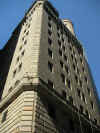|
New York Architecture Images-New York Architects Samuel Yellin |
||||
| New York works; | ||||

|
||||
| 027-Central Savings Bank | ||||
|
Samuel Yellin (1885–1940) was America's master iron
craftsman of the twentieth century. From his workshop in Philadelphia,
Yellin created magnificent medieval- and Renaissance-inspired ironwork
for buildings across the country. In New York, major installations of
Yellin ironwork are evident at York and Sawyer's Central Savings Bank
(1926–28) and Federal Reserve Bank (1919–24).
Born: 3/2/1885, Died: 10/3/1940 Speaking to the Architectural Club of Chicago in 1926, Samuel Yellin succinctly described his design process: There is only one way to make good decorative ironwork and that is with the hammer at the anvil, for in the heat of creation and under the spell of the hammer, the whole conception of a composition is often transformed." (See the link below for the full text of this lecture.) Samuel Yellin was a leader in the revival of crafts that Philadelphia experienced in the early twentieth century. Along with stained glass artist Nicola D'Ascenzo Yellin encouraged a greater attention to the arts which were applied to buildings, working with notable architects all across the country and drawing considerable attention to Philadelphia as a center for the American Arts and Crafts Movement. Born and trained in Poland, Samuel Yellin diverted from the career of his father (an attorney) to study art and to apprentice with an ornamental metalworker. He came to Philadelphia in 1906, and his abilities soon brought him to the attention of the Pennsylvania Museum and School of Industrial Arts, which engaged him as an instructor in their metalworking classes. He would work with the PMSI from 1907 to 1922. By 1909 he had opened his own studio, and by 1915 Mellor & Meigs, an architectural firm with which he was closely associated, had designed his studio/showroom on Arch Street in West Philadelphia. There he and his staff (eventually over 200 craftspeople) would churn out hundreds of designs for gates, lighting fixtures, screens, grilles, railings, doors, all sorts ironwork, from the monumental to the small. Residences, cathedrals, banks, academic buildings -- all could be enhanced with Yellin's unique approach to the use of metalwork; and his clients included both Yale and Harvard Universities, as well as Washington Cathedral (DC), Grace Cathedral (San Francisco), and the Cathedral of St. John the Divine (New York, NY). Nor were his designs limited to public clients. The wealthy (Edward W. Bok, Lammont Dupont, H. H. Flagler, Robert Goelet, etc.) also commissioned Yellin's studio to produce embellishments for their country and city homes. All of these commissions brought Yellin into a circle of elite architects who worked not just in Philadelphia, but all across the country, creating many of the most publicized buildings of the early twentieth century. Yellin's work often emphasized traditional styles, but he still molded those styles to the needs of the clients and to his own ideas regarding craft. In his 1926 lecture to the Architectural Club of Chicago Yellin clearly states his attitude toward tradition in design:
With all of his commercial success, Samuel Yellin never lost his love of the material and his desire to celebrate the craft. He contributed the essay on "Iron Art" to the eminent 14th edition of the Encyclopedia Britannica, and he was invited by the Philadelphia Museum of Art to act as consultant on their collection of historic crafts. Furthermore, beginning in 1919 he also received several medals acknowledging his contributions, including awards from the Chicago Art Institute (1919), American Institute of Architects (1920), Architectural League of New York (1922), and, locally, the Bok Civic Award (1925). Written by Sandra L. Tatman. Clubs and Membership Organizations
School Affiliations
Links to Other Resources
|
||||
|
links |
||||